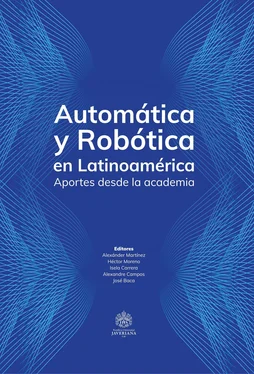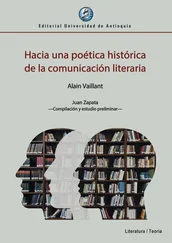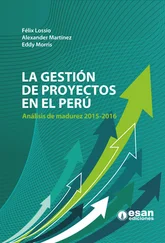[18] M. Chen Austin, I. Chang, D. Bruneau, and A. Sempey, “Assessment of Different Approaches to Model the Thermal Behavior of a Passive Building via System Identification Process”, in Advances in Automation and Robotics Research (vol. 112), A. Martinez, H. A. Moreno, I. G. Carrera, A. Campos and J. Baca, Eds. Zurich, Switzerland: Springer, 2020, pp. 185–193.
[19] J. Baca et al., “Design and Simulation Analysis of a Modular Aerial System”, in Advances in Automation and Robotics Research (vol. 112), A. Martinez, H. A. Moreno, I. G. Carrera, A. Campos and J. Baca, Eds. Zurich, Switzerland: Springer, 2020, pp. 112–118.
[20] G. A. Guijarro Reyes et al., “Deep Neural Network-Inspired Approach for Human Gesture-Triggered Control Actions Applied to Unmanned Aircraft Systems”, in Advances in Automation and Robotics Research (vol. 112), A. Martinez, H. A. Moreno, I. G. Carrera, A. Campos and J. Baca, Eds. Zurich, Switzerland: Springer, 2020, pp. 92–111.
[21] A. Martinez Alvarez, and C. A. Lozano Espinosa, “Nonlinear control for collision-free navigation of UAV fleet,” SN Appl. Sci., vol. 1, no. 12, art. 1577, Dec. 2019, doi: 10.1007/s42452-019-1606-x.
[22] I. Banfield, and H. Rodriguez, “A Multi-Objective Genetic Algorithm Approach for Path Planning of an Underwater Vehicle Manipulator”, in Advances in Automation and Robotics Research (vol. 112), A. Martinez, H. A. Moreno, I. G. Carrera, A. Campos and J. Baca, Eds. Zurich, Switzerland: Springer, 2020, pp. 119–130.
[23] N. N. Romero, A. Campos, D. Martins, and R. S. Vieira, “A new approach for the optimal synthesis of four-bar path generator linkages”, SN Appl. Sci., vol. 1, no. 11, art. 1504, 2019. doi: 10.1007/s42452-019-1511-3.
[24] A. Campos, and Y. D. Moratelli, “Graphical Optimization for a Parallel Robot Rotation Based on Platform Initial Orientation”, in Advances in Automation and Robotics Research (vol. 112), A. Martinez, H. A. Moreno, I. G. Carrera, A. Campos and J. Baca, Eds. Zurich, Switzerland: Springer, 2020, pp. 40–50.
[25] H. Moreno, O. Zendejo, I. Carrera, J. Baca, and I. Calderón, “Static Force Analysis of a Variable Geometry Legged Wheel”, in Advances in Automation and Robotics Research (vol. 112), A. Martinez, H. A. Moreno, I. G. Carrera, A. Campos and J. Baca, Eds. Zurich, Switzerland: Springer, 2020, pp. 64–71.
[26] J. C. Gallo, and P. F. Cárdenas, “Designing an Interface for Trajectory Programming in Industrial Robots Using Augmented Reality”, in Advances in Automation and Robotics Research (vol. 112), A. Martinez, H. A. Moreno, I. G. Carrera, A. Campos and J. Baca, Eds. Zurich, Switzerland: Springer, 2020, pp. 142–148.
[27] D. A. Bravo, C. F. Rengifo R, and W. Acuña, “Dynamics and Preview Control of a Robotics Bicycle”, in Advances in Automation and Robotics Research (vol. 112), A. Martinez, H. A. Moreno, I. G. Carrera, A. Campos and J. Baca, Eds. Zurich, Switzerland: Springer, 2020, pp. 248–257.
[28] C. Ramirez, P. Hurtado, C. Sanabria, and K. Ramirez, “Design of a Low-Cost Ball and Plate Prototype for Control Education”, in Advances in Automation and Robotics Research (vol. 112), A. Martinez, H. A. Moreno, I. G. Carrera, A. Campos and J. Baca, Eds. Zurich, Switzerland: Springer, 2020, pp. 258–265.
[29] J. Garzón, J. Alfonso, L. Fernandez-Samacá, and C. Sanabria, “Modeling and Antibalance Control of a Birail Crane”, in Advances in Automation and Robotics Research (vol. 112), A. Martinez, H. A. Moreno, I. G. Carrera, A. Campos and J. Baca, Eds. Zurich, Switzerland: Springer, 2020, pp. 149–156.
Sección I
Artículos cortos
En esta sección se encuentran los artículos cortos que respaldan algunas de las ponencias realizadas en LACAR2019, en las que se presentaron resultados de proyectos de investigación y desarrollo tecnológico efectuados en distintas universidades de Latinoamérica.
Optimal energy transmission analysis through rotating machinery
J. Alan Calderón Ch.γ,1,2, Julio C. Tafur1, Benjamín Barriga1
1 Engineering Department, Mechatronic Master Program,
Pontificia Universidad Católica del Perú
Lima, Perú
2 Applied Nanophysics, Institute for Physics
Technical University of Ilmenau
Ilmenau, Germany
γ. Corresponding author: alan.calderon@pucp.edu.pe
Active Magnetic Bearings (AMB) are wide studied and applied nowadays, as for example in mining, petrol companies, power generator stations, etc. It is because this system improves efficiency in energy transmission as the consequence of controlled magnetic force over the shaft, which joins the source of the mechanical energy with the rotating machine (turbine, compressor, pump). Notwithstanding, shafts transmit not only rotating speed, also torque and quite advances of industry forced that shaft rotates at high speed values. Therefore, sensors and actuators must to be faster than this, but whether AMB cannot get an optimal position control, the electrical current, which produces the magnetic field to achieve the controlled magnetic force, will provoke heat through the wires that contain it. For this reason, in this work is analyzed the impact of sensors and actuators that were based in nanostructures in order to get faster response time and robustness, while AMB system can find its desired position control. Furthermore, while the heat is reduced also from their magnets, the total efficiency can be transmitted in better percent than AMB without faster and robust sensors.
Keywords: Rotating machinery, bearings, Active Magnetic Bearings, heat transmission, nanostructures.
Rotating machinery are frequently applied to transmit movement and energy, as it was given in electrical energy production, such as in intricate geographical areas, where there are fast flowing rivers (as for example, in Andes mountains rivers). Therefore, it is necessary energy conversion and transmission from mechanical energy to electrical energy by specific systems, such as turbines and electrical transformers. By other side, also there are applications, in which is very important to use rotating machines, because of mechanical movement transmission: mining, agriculture, fishing and every economic activity, which needs mechanical movement transmission. Nevertheless, while there is not good energy transmission in systems as it was described above, it will be necessary to use some mechanisms to reduce the produced heat in mechanical movement conveying that generally pollutes the environment.
To prepare this research, it was used a VARIAC (trademark for Variable Autotransformer) to get speed control in the rotor system that is composed by an alternating control (AC) engine that was coupled with a rotor, for which it is supported by an Active Magnetic Bearing (AMB) control. Also, owing to control algorithm strategies, it was studied some consequences (advantages and disadvantages) from nanostructures over the main control system, while energy transmission process goes through the other mechanical systems that is joined with the rotor [1], [2], [5].
Furthermore, it was necessary to obtain a general mathematical model to describe energy transmission through the proposed system, in which the nonlinear model gave a good solution. The consequence effect to join sensors and actuators that were based in nanostructures support is the energy balance in all the mechanical system. It is because nanostructures robustness and fast response, which are the integration from nanosystem to macro system generate another good consequence: increase the efficiency of mechanical systems, because of reducing energy losses (heat) and in this context there would not be necessary so intense refrigeration complements [2], [3], [4], [5].
Читать дальше












